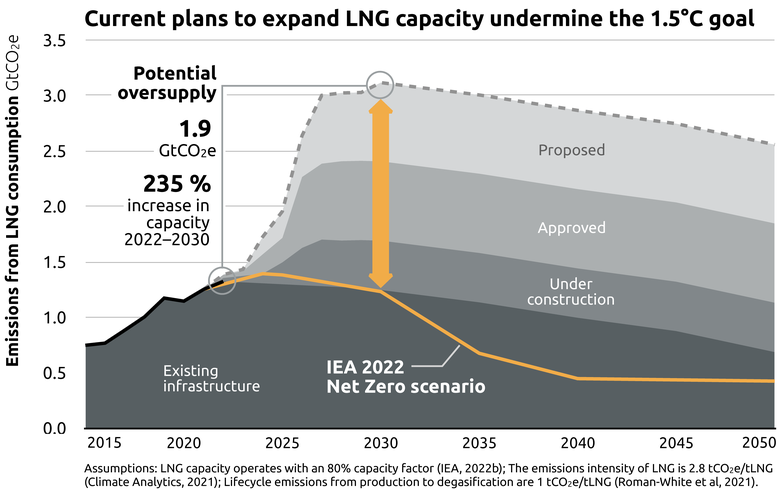Dash for gas a serious threat to the Paris Agreement’s warming limit
Attachments
Press release
The world has overreached in its bid to respond to the energy crisis, to the extent that emissions from new gas capacity now threaten the 1.5˚C warming limit, says new analysis from the Climate Action Tracker.
In its COP27 update, the Climate Action Tracker has calculated the CO2 emissions from all the under-construction, approved and proposed Liquefied Natural Gas (LNG) production projects between 2021 and 2050, finding they could add up to around 10% of the remaining global carbon budget for 1.5˚C warming by mid-century.
In 2030, oversupply of LNG could reach 500 megatonnes of LNG, equivalent to almost five times the EU’s 2021 Russian gas imports, and double total global Russian exports. This oversupply of fossil gas could lead to excess emissions of at just under two gigatonnes of CO2 a year in 2030, well above emission levels consistent with the IEA Net Zero by 2050 scenario (2022).
“The energy crisis has taken over the climate crisis, and our analysis shows proposed, approved and under construction LNG far exceeds what’s needed to replace Russian gas,” said Bill Hare, CEO of CAT partner organisation Climate Analytics.
“We’re witnessing a major push for expanded fossil gas LNG production and import capacity across the world – in Europe, Africa, North America, Asia and Australia – which could cause global emissions to breach dangerous levels. Increasing our reliance on fossil gas cannot be the solution to today’s climate and energy crises anywhere.”
Warming projections same as Glasgow
Meanwhile, the CAT’s annual warming projections, also released today, have not moved the thermometer at all, as few governments have increased their 2030 targets, made new net zero commitments nor substantiated them.
Warming in 2100 given all 2030 national targets would be 2.4˚C, the same as the CAT projected in Glasgow; including the long term net zero commitments would take it to 1.8˚C and the current policies pathway – a reflection of action on the ground – remains at 2.7˚C.
“With governments focussing on the energy crisis, this has been a year of little action on the climate: almost no updated national climate targets for 2030 and no significant increase in participation in Glasgow initiatives on coal phase out, clean cars and methane,” said Prof. Niklas Höhne, of CAT partner organisation NewClimate Institute. “And without strong 2030 action, governments cannot reach net zero.”
“2022 has been a year of climate havoc, with Pakistan still underwater, wildfires raging across Europe, Russia and North America, and record heatwaves. This lack of action is pretty disappointing: while the US has finally implemented a massive climate package, there’s been good news from China’s 14th Five year Plan, and potential over achievement of the EUs climate target, there’s been little movement on finance, and almost no progress at all made on Glasgow’s sectoral initiatives," said Höhne.
“As with last year, with all proposed actions, global emissions in 2030 will still be twice as high than they should be for the 1.5 degree limit. To limit warming to 1.5˚C, countries need to flip to emergency mode on climate as they do on the energy crisis.”
The CAT COP27 update sets out a detailed analysis of action by the 41 countries the CAT analyses, equal to around 80% of global emissions.
Stay informed
Subscribe to our newsletter

